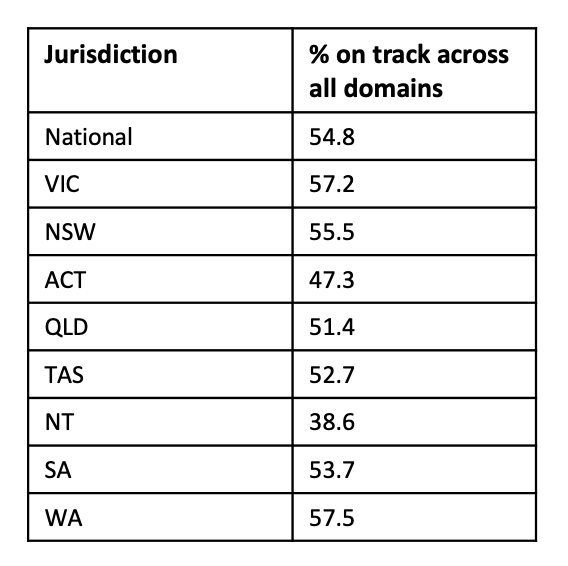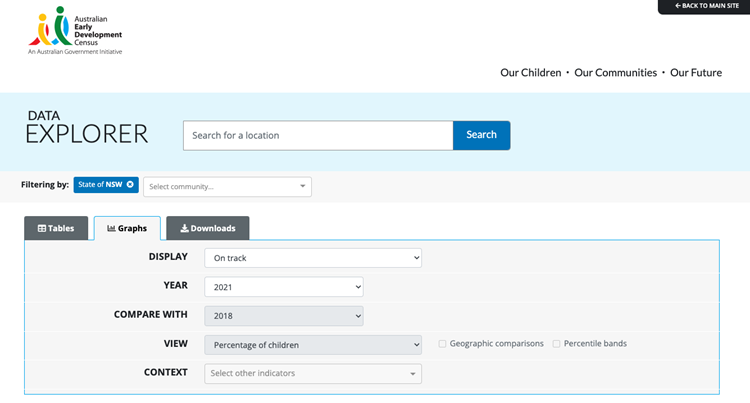Top level summary:
The latest release shows that while COVID-19 and lockdowns have impacted on children’s development, particularly in relation to the language and cognitive skills domain, the impact may not be as significant as we may have expected. The impact, however, does not appear to have been evenly felt, with larger increases in developmental vulnerability seen for Aboriginal and Torres Strait Islander children and children living in the most disadvantaged areas of Australia.
- Developmentally, the majority of children are on track across the five domains, but the trend of historical increases reversed slightly in 2021
- While there has been a significant improvement in children’s development since 2009, when the AEDC first commenced, between 2018 and 2021 there has been a significant decline
- There had been steady gains for Aboriginal and Torres Strait Islander children in the five domains from 2009 to 2018, but a slight reversal was seen in 2021
- In 2021, there was an increase in developmental vulnerability for children living in regional and remote areas, driven primarily by fewer children on track in their language and cognitive skills (school-based)
- Since the AEDC commenced in 2009, the proportion of children with special needs requiring further assessment has increased significantly from 10.7% of children to 16.3% in 2021
What is the AEDC?
The AEDC provides a national measurement to monitor Australian children’s development. Conducted every 3 years, the census measures children’s development across five domains:
- Physical health and wellbeing
- Social competence
- Emotional maturity
- Language and cognitive skills (school based)
- Communication skills and general knowledge.
The AEDC provides population level data which can be used to inform health, education, and community support policies for young children and families.
How can ECEC services use the data?
ECEC services can use the data to understand the developmental outcomes children in their communities are arriving at school with, and to better plan the services to meet the needs of children who will access them in the future.
High level findings
The 2021 release is particularly significant because it captures data about children impacted by COVID-19 and subsequent lockdowns.
The majority of children are developmentally on track on all five domains of early childhood development.
- These figures had been steadily increasing over time, from around 50.7% in 2009 to 55.4% in 2018.
- In 2021, however, the percentage of children who were on track in all five domains decreased slightly to 54.8%.
The 2021 AEDC data also shows a small but significant increase in the percentage of children who were classified as ‘developmentally vulnerable.’
- In 2021, the percentage of children classified as developmentally vulnerable in one or more domain(s) increased from 21.7% in 2018 to 22.0% in 2021.
- The percentage of children who were classified as developmentally vulnerable in two or more domains also increased from 11.0% in 2018 to 11.4% in 2021.1
In short, the 2021 data shows, while there has been a significant improvement in children's development since 2009, when the AEDC first began, there was a significant decline between 2018 and 2021.
Children from equity groups
We know that children who are Aboriginal and Torres Strait Islander, from disadvantaged households or from culturally and linguistically diverse families, tend to be more likely to be developmentally vulnerable in one or more of the AEDC domains.
The 2021 National AEDC Report shows that:
- From 2009 to 2018, there had been a steady increase in the percentage of Aboriginal and Torres Strait Islander children on track in five domains, however 2021 saw a slight reversal in these gains.2
- Children living in the most socio-economically disadvantaged communities are twice as likely to be vulnerable in one or more AEDC domains. In 2021, there was increased3 developmental vulnerability in one or more and two or more domains for children across the socio-economic spectrum (more so for children living in our most socio-economically disadvantaged areas).4
- Since 2009, we have seen improvements in the percentage of children with a language background other than English who are developmentally on track across all domains.5
- In 2021, there was an increase in developmental vulnerability for children living in regional and remote areas, driven primarily by fewer children on track in their language and cognitive skills (school-based).6
Children with disability, additional or special needs
There are 5.2% of children with special needs status in the 2021 collection, which has increased since 2018 where there were 4.6%.
Interestingly, the proportion of children with special needs requiring further assessment (eg. medical and physical, behaviour management, emotional and cognitive development) has increased significantly each year since the AEDC commenced, from 10.7% of children in 2009 to 16.3% in 2021.
Jurisdictional changes of note
The table below shows the proportion of children developmentally ‘on track’ across all domains by jurisdiction:

With many of CELA’s members based in NSW, it is worth noting that:
- The proportion of children on track for the physical health and wellbeing domain declined from 78.5% in 2009 to 78.1% in 2021
- Social competence declined from 77.2% in 2009 to 76.1% in 2021
- Emotional maturity increased from 78.3% in 2009 to 79.1% in 2021 (but a decline from the 2018 high of 80.2%)
- Compared with the 2015 high of 87.9%, language and cognitive (schools-based) dropped back to just better than 2009 levels (now at 84.9% on track)
- There was a slight decrease in the proportion on track for communication skills and general knowledge
Think Local - drilling down to the community level and planning to meet children’s needs
The AEDC data explorer tool enables services to drill down to their local community level data to find out how children in their community compare with all children in the state or nationally, as well as how the results have changed over time.
 (Image of data explorer tool via www.aedc.gov.au/data-explorer)
(Image of data explorer tool via www.aedc.gov.au/data-explorer)
A service could, for example, search for their community and see what domains have changed between 2018 and 2021 and plan educational programs and strategies accordingly.
Below we have the results for the proportion of children on track in a coastal community in NSW comparing results between 2018 and 2021. In the five domains, the data shows that there has been a significant decline in the percentage of children 'on track' for the language and cognitive skills domain (mirroring the national trends), as well as the emotional maturity domain.

'On track' for the language and cognitive skills (school-based) domain in the AEDC is defined as “Children will be interested in books, reading and writing, and basic math; capable of reading and writing simple sentences and complex words. Will be able to count and recognise numbers and shapes.”
'On track' for the emotional maturity domain is definted as "Almost never show aggressive, anxious, or impulsive behaviour. Children will have good concentration and will often help other children.
Download 'About the AEDC domains' overview
Educators in this community may reflect on what has driven the decrease. It is likely a result of reduced attendance at education and care in 2020 due to the pandemic, but have there been other changes in the make-up of the community or in the educational programs on offer? The change can be used as a discussion point when designing educational programs for the year ahead.
Educators can also view how the community profile across the five domains compares with the state and national figures, which can inform priorities in designing educational programs and supports for children.
Documenting these discussions and subsequent agreed actions, including strategies for monitoring changes, could feature in a service’s quality improvement plan as a strength, as it relates to Quality Area 1 Element 1.3.2 – “Critical reflection on children’s learning and development, both as individuals and in groups, drives program planning and implementation.”7
What it means for early education and care policy more broadly
The latest release shows that while COVID-19 and lockdowns have impacted on children’s development, particularly in relation to the language and cognitive skills domain, the overall impact may not be as significant as we may have expected.
However the AEDC National Report does say:
“The impact, however, does not appear to have been evenly felt, with larger increases in developmental vulnerability seen for Aboriginal and Torres Strait Islander children and children living in the most disadvantaged areas of Australia.”8
It notes that while more data is emerging, the data from the census overall shows the importance of:
“Ensuring younger cohorts are well supported over the coming years – with a focus on mitigating impacts for families most affected in their access to employment, social support, and early education and care.”9
CELA’s advocacy on behalf of children and education and care services
Much of the findings reinforce what CELA has heard from members over the past two years. The proportion of children displaying challenging behaviours and needing additional supports has increased, but the funding needed to support them is often too little and slow to arrive. We know from the Australian Institute of Family Studies Evaluation of the Childcare Subsidy Package that around 11% of services have turned some children away due to not being able to meet their needs10.
Many vulnerable children, who benefit most from access to high quality early education and care, have left services due to families’ lack of confidence around their incomes during the pandemic. Floods across much of NSW and QLD have put further strain on these communities.
Communities which are disadvantaged are often unable to access high quality education and care, or indeed any education and care at all.
Our 6 Point Plan for Education and Care
Our 6 Point Plan for Education and Care, which we have developed with like-minded peak bodies, ELAA and CCC, will help address many of the issues of equity and access to high quality education and care for Australian children, 1 in 5 of whom start school behind.
In our plan, we are calling for:
- Two days a week of funded early education and care for all children from birth to school
- A commitment to the inclusion of all children
- Mandatory National Quality Standard assessments and ratings at least every three years
- The creation of a national industrial instrument for the education and care sector to provide educators with fairer levels of pay
- A National Children’s Education & Care Workforce Strategy
- Properly funded infrastructure and sector support
What we ask of you
With an election looming, please contact us to share your stories about why high-quality education and care is important – not just so that women can work, but because of the critical role it plays in supporting children’s learning and development.
Email our CEO Michele Carnegie at michelecarnegie@cela.org.au
Keep an eye out for our forthcoming survey to tell us about your experiences working with vulnerable children — the challenges, the successes, and what’s needed to ensure all children get the support they need.
References:
1. AEDC National Report (2021), Australian Early Development Census, page 8
2. AEDC National Report (2021) page 5
3. Ibid. page 5
4. Ibid. page 5
5. Ibid. page 5
6. Ibid. page 5
7. National Quality Standards, ACECQA (accessed 5 April 2022)
8. AEDC National Report (2021), Department of Education, Skills and Employment, page 25
10. Child Care Package Evaulation: Final Report, (August 2021), J. Rob Bray, Jennifer Baxter, Kelly Hand, Matthew Gray, Megan Carroll, Richard Webster, Ben Phillips, Mikayla Budinski, Diana Warren, Ilan Katz and Anna Jones, Australian Institute of Family Studies, page 203